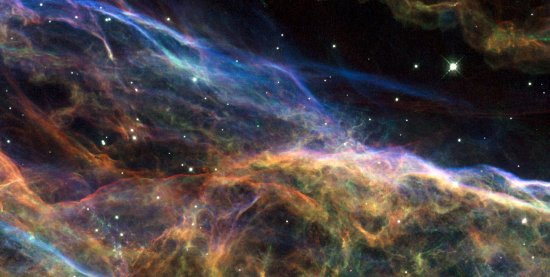Although we don’t usually think about it, the stars twinkling in the night sky don’t shine forever. How long a star lives depends on how big and heavy it is. The bigger the star, the shorter its life. When a star significantly heavier than our Sun runs out of fuel, it collapses and blows itself apart in a catastrophic supernova explosion. A supernova releases so much light that it can outshine a whole galaxy of stars put together. The exploding star sweeps out a huge bubble in its surroundings, fringed with actual stellar debris along with material swept up by the blast wave. This glowing, brightly-coloured shell of gas forms a nebula that astronomers call a ‘supernova remnant’. Such a remnant can remain visible long after the initial explosion fades away.
A series of three new images taken with the NASA/ESA Hubble Space Telescope reveals magnificent sections of one of the most spectacular supernova remnants in the sky – the Veil Nebula. The entire shell spans about 3 degrees, corresponding to about 6 full moons. The small regions captured in the new Hubble images provide stunning close-ups of the Veil. Fascinating smoke-like wisps of gas are all that remain visible of what was once a Milky Way star.
Scientists estimate that the supernova explosion occurred some 5-10,000 years ago and could have been witnessed and recorded by ancient civilizations. These would have seen a star increase in brightness to roughly the brightness of the crescent Moon.
The intertwined rope-like filaments of gas in the Veil Nebula result from the enormous amounts of energy released as the fast-moving debris from the explosion ploughs into its surroundings and creates shock fronts. These shocks, driven by debris moving at 600,000 kilometres per hour, heat the gas to millions of degrees. It is the subsequent cooling of this material that produces the brilliantly coloured glows.

More over here.